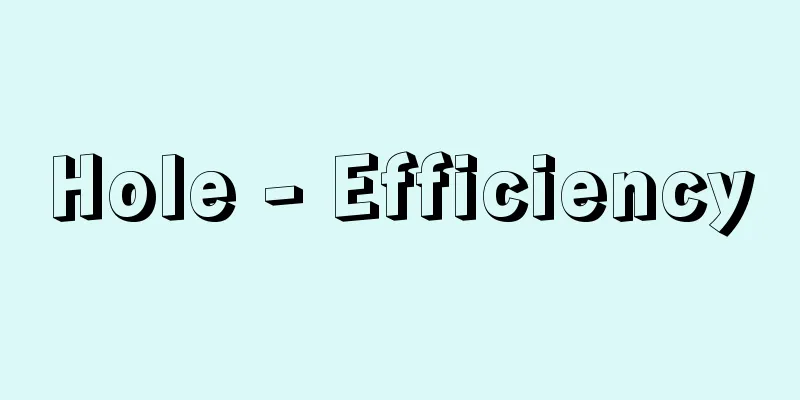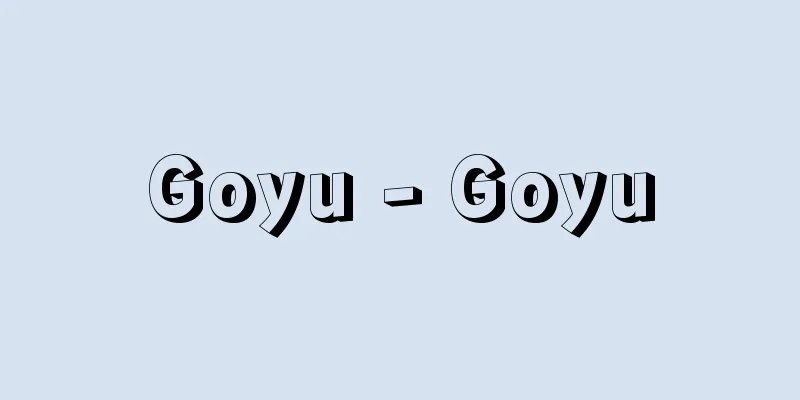Artificial insemination

|
This is a technique in which male sperm is collected by artificial means and injected into the female's internal reproductive organs to establish conception. Insemination is the injecting of sperm into the female reproductive organs, and does not necessarily result in fertilization, the fusion of sperm and eggs. Therefore, the term artificial insemination is used for in vitro fertilization, but artificial insemination is used for internal conception, and the two should not be confused. [Yoichi Shoda] For livestockThe Italian biologist Spallanzani was the first to experimentally prove the feasibility of artificial insemination, conducting tests on dogs in 1780. In 1907, the Russian EI Ivanov (1870-1932) successfully applied this technique to horses, leading to widespread use and practical application as an extremely effective means of improving and breeding livestock. In particular, since the development of a method for freezing and storing bovine semen in 1952, artificial insemination using frozen semen has spread rapidly in cattle, particularly dairy cows. Currently, 99% of dairy cows in Japan are bred through artificial insemination, and 98% of these use frozen semen. [Yoichi Shoda] Effects of artificial inseminationThe effects of applying this technology to livestock breeding include the following, but the greatest effect is on breeding. It is possible to produce hundreds of times the number of offspring from a single male animal compared to natural mating, which allows for effective use of superior breeding stock and strict selection of males. Progeny testing can also be carried out at an early stage, which increases the speed of improvement. From a management perspective, it eliminates the need to transport livestock for mating, and breeding stock can be used over a wide area, reducing the expenses and labor required to raise male livestock on individual farms or ranches. From a hygiene perspective, it helps prevent reproductive infectious diseases, and has the advantage of allowing animals that are unable to mate naturally due to malfunction to be used for breeding. In addition, there has been a growing need in recent times to breed rare and endangered animals in captivity, and this technique is often used in these cases to avoid the difficulties of pairing wild animals. [Yoichi Shoda] Artificial insemination techniques(1) Semen collection The most common method is the artificial vagina method. A male mounts a dummy or a female animal in heat and collects semen through an artificial vagina. Other methods include giving electrical stimulation to a part of the body to induce ejaculation, and massage methods. The abdominal massage method is widely used for poultry. (2) Semen quality test The collected semen is first examined visually for volume, concentration, color, odor, hydrogen ion concentration (pH), etc., and then examined under a microscope for sperm vitality, sperm count, and the rate of abnormal sperm. (3) Dilution and storage of semen For storage and because it is necessary to distribute it to many individuals, semen is diluted with a diluent. Egg yolk buffer or milk buffer is used as the liquid. It can be stored in liquid or frozen state, but in the case of frozen storage, glycerin is added to the diluent beforehand to protect the sperm from the harmful effects of freezing, and dry ice (around -80°C) or liquid nitrogen (-196°C) is used. Frozen semen can be stored for several years without losing its fertilization ability. (4) Injection of semen After thawing, if the frozen semen is stored in liquid form, it is injected directly into the female livestock's reproductive tract using an injector. The injection site varies depending on the animal species, but in cattle it is either inside the uterus or deep inside the cervix, and the number of sperm injected is usually 25 to 50 million. The timing of injection must be selected taking into account the time of ovulation and the time the sperm retain their fertilizing ability. In cattle, it is usually from the middle to the end of estrus, but in order to increase the conception rate, it is desirable to inseminate twice during one estrus. [Yoichi Shoda] In humansArtificial insemination is the delivery of sperm to the vicinity of the ampulla of the fallopian tube, where fertilization occurs, and is a commonly used treatment for male infertility. In cases of asthenozoospermia, where there is a low sperm count or sperm motility is poor, the number of sperm necessary for fertilization cannot reach the ampulla of the fallopian tube. In such cases, sperm that have been manually collected and prepared are injected into the cervix or uterine cavity on the day of ovulation, or even into the fallopian tube, in the hope that fertilization will occur within the fallopian tube. With artificial insemination, fertilization occurs inside the body. [Yasunori Yoshimura April 17, 2015] kindsArtificial insemination using the husband's sperm is called artificial insemination with husband's semen (AIH), and artificial insemination using sperm from a donor other than the husband is called artificial insemination with donor's semen (AID). [Yasunori Yoshimura April 17, 2015] IndicationsIn general, indications for artificial insemination include (1) quantitative or qualitative abnormalities in sperm or semen, (2) functional infertility, and (3) ejaculation disorder or sexual intercourse disorder. The total number of motile sperm that can result in pregnancy through artificial insemination is said to be 10 x 106 or more. In general, if the total number of motile sperm in the uncut semen is 10 x 106 or less, and the infertility period is more than two years, in vitro fertilization is indicated. Artificial insemination is chosen in cases of infertility of unknown cause, where pregnancy does not occur even after a certain period of guidance on timing to coincide with ovulation. For patients with infertility of unknown cause who have been infertile for more than three years, the pregnancy rate per cycle with timing alone is said to be only 3%, so they move on to artificial insemination and in vitro fertilization. When combined with ovulation induction, the success rate of artificial insemination increases. Some cases of infertility of unknown cause include egg pickup failure in the fimbria of the fallopian tubes and fertilization failure, and in these cases, pregnancy cannot be expected with artificial insemination, so in vitro fertilization should be considered early. The pregnancy rate per cycle with AIH is 7-8%. [Yasunori Yoshimura April 17, 2015] methodGenerally, an egg is capable of being fertilized for approximately 12 to 24 hours after ovulation, and sperm have a lifespan of around two days, so it is important to perform artificial insemination at the right time close to ovulation. In combination with artificial insemination, ovulation inducers such as clomiphene and gonadotropin preparations are often used. In cases of unexplained infertility, superovulation ovarian stimulation is considered to be clearly effective with either clomiphene or gonadotropin preparations, but there is a possibility of side effects such as multiple pregnancy and ovarian hyperstimulation syndrome (symptoms such as ovarian enlargement and accumulation of ascites). If there is a possibility of ovulation of three or more follicles, consider canceling artificial insemination. A period of abstinence of 2-3 days results in a higher pregnancy rate. It is also said that pregnancy rates are higher if the sperm are processed within 30 minutes of collection and artificial insemination is performed within 90 minutes. Sperm are processed using the Percoll density gradient method or the swim-up method, using semen or washed sperm. The Percoll density gradient method uses the density gradient carrier Percoll (particles of colloidal silica coated with polyvinylpyrrolidone) to separate dense, mature sperm. In the swim-up method, culture medium is layered over semen or washed sperm, and the sperm are allowed to stand in the culture medium for 30-60 minutes. Sperm with good motility swim up into the culture medium, which are then collected, washed, and used for insemination. Artificial insemination tubes have been replaced by metal insemination needles, and soft insemination catheters are now recommended. The sperm suspension should be injected slowly over 15 seconds or more. Remaining still for 10 minutes or more after the procedure increases the chances of pregnancy compared to moving immediately. Antibiotics are often administered after artificial insemination to prevent infection. The advantages of artificial insemination are that it is minimally invasive and low cost, and it has been evaluated to a certain extent as a treatment prior to in vitro fertilization. However, its indications, methods, and results vary between facilities. It is important to consider the age of the mother and other factors and present appropriate treatments such as in vitro fertilization and intracytoplasmic sperm injection, rather than simply repeating artificial insemination. [Yasunori Yoshimura April 17, 2015] Non-marital artificial insemination (AID)Indications are those with a medical condition where there is no possibility of having a child by any other method, generally azoospermia. In addition, it is also indicated when the attending physician judges that pregnancy is not possible after multiple intracytoplasmic sperm injection (ICSI) procedures, or when it is judged that using the husband's sperm to try to get pregnant would pose a serious risk to the mother or child (such as when the husband has a serious infection). The Japan Society of Obstetrics and Gynecology has its own opinion on AID, and it is carried out in accordance with this. Prior to treatment, it is necessary to confirm whether the couple is legally married and whether the husband has given his consent in order to determine the legal status of the child to be born. Consent is also confirmed each time treatment is administered. In order to reduce the risk of infectious diseases such as AIDS, the sperm suspension after washing the semen is frozen for six months, and then the donor is reconfirmed to be free of infectious diseases. The thawed sperm suspension is then injected into the wife's uterus on the day of ovulation. [Yasunori Yoshimura April 17, 2015] For legal issues regarding artificial insemination (artificial insemination and in vitro fertilization), please see the "Artificial insemination" entry. [Editorial Department] [References] | | | | |Source: Shogakukan Encyclopedia Nipponica About Encyclopedia Nipponica Information | Legend |
|
人為的な手段で雄の精液を採取し、これを雌の内部生殖器内に注入して受胎を成立させる技術をいう。授精inseminationとは雌の生殖器内に精子を授けることで、かならずしも精子と卵子の融合である受精fertilizationを招来するとは限らない。したがって体外受精の場合は人工受精の語を用いるが、体内で受胎させる場合は人工授精で、両者を混同してはならない。 [正田陽一] 家畜の場合人工授精の可能性を初めて実験的に証明したのは、イタリアの生物学者スパランツァーニで、1780年にイヌを用いて試験を行った。そしてこの技術は1907年、ロシアのイワーノフE. I. Ivanov(1870―1932)がウマに応用して成功したことから、家畜の改良、増殖のうえできわめて有効な手段として、広く普及し実用化されることになった。ことに1952年、ウシの精液の凍結保存法が開発されて以来、ウシとくに乳牛においては凍結精液を用いた人工授精が急速に広まった。現在日本の乳牛の99%が人工授精により繁殖しており、そのうちの98%は凍結精液を用いている。 [正田陽一] 人工授精の効果家畜の繁殖にこの技術を応用した場合の効果には次のようなものがあげられるが、そのなかでも育種上の効果がもっとも大きい。すなわち、1頭の雄畜の子の数を自然交配の場合の数百倍にもすることが可能であるので、優良な種畜の有効な利用ができ、雄についての厳しい選抜が可能になる。また後代検定も早期に実施できるので改良の速度も増進する。管理の面からは、交配のための家畜の輸送が不必要となり、種畜の広範囲な利用ができるため、個々の農家または牧場で雄畜を飼養する経費、労力が節減される。衛生面では生殖器伝染病の予防にも役だつうえ、故障で自然交配ができない個体も繁殖に供用できるなどの利点がある。 このほか最近では、絶滅に瀕(ひん)した希少動物を飼育下で繁殖させる必要性が高まってきて、その場合に野生動物のペアリングの困難性を回避するためにも、この技術がしばしば利用される。 [正田陽一] 人工授精の技術(1)精液採取 もっとも普及しているのは人工腟(ちつ)法である。擬雌台もしくは発情雌畜に雄を乗駕(じょうが)させて人工腟により採精する。このほか体の一部に電気刺激を与えて射精させる方法や、マッサージ法があり、家禽(かきん)類では腹部マッサージ法が広く用いられている。 (2)精液の性状検査 採取した精液はまず精液量、濃度、色、臭気、水素イオン濃度(pH)などを肉眼的に検査し、ついで精子活力、精子数、奇形精子率を顕微鏡下で調べる。 (3)精液の希釈・保存 精液は保存のため、また多数の個体に分注する必要から希釈液で希釈される。液としては卵黄緩衝液や牛乳緩衝液が用いられている。保存は液状あるいは凍結状態でされるが、凍結保存の場合は凍結の悪影響から精子を守るため希釈液にあらかじめグリセリンを添加しておき、ドライアイス(零下80℃前後)か液体窒素(零下196℃)を用いる。凍結した精液は受精能力を低下させることなく数年間も保存できる。 (4)精液の注入 凍結精液は解凍してから、液状保存の場合はそのまま注入器を用いて雌畜の生殖器内に注入する。注入部位は各動物種により一定しないが、ウシでは子宮内か頸管(けいかん)深部で、注入精子数は通常2500万~5000万である。注入の時期は、排卵の時間、精子の受精能力保有時間を考え適期を選ばねばならない。ウシでは発情の中期から末期へかけてとされているが、受胎率を高めるためには1発情期に2回授精することが望ましい。 [正田陽一] ヒトの場合人工授精とは、精子を受精の場である卵管膨大部の近くに送り届けることであり、男性不妊の治療法として汎用(はんよう)されている。精子の数が少ない、あるいは精子の運動が不良な精子無力症では、受精に必要な数の精子が卵管膨大部まで到達できない。このような症例では、用手的に採取し調整した精子を、排卵日に子宮頸管あるいは子宮腔(くう)内、さらには卵管内に注入し、卵管内で受精が成立することを期待する。人工授精では体内で受精がおこる。 [吉村泰典 2015年4月17日] 種類夫の精子を用いるものを配偶者間人工授精(artifical insemination with husband's semen:AIH)、夫以外の提供者の精子を用いるものを非配偶者間人工授精(artifical insemination with donor's semen:AID)という。 [吉村泰典 2015年4月17日] 適応一般に、人工授精の適応は、(1)精子・精液の量的・質的異常、(2)機能性不妊、(3)射精障害・性交障害などがあげられる。人工授精で妊娠可能な総運動精子数は、10×106個以上とされる。一般に原精液の総運動精子数が10×106個以下の場合には、不妊期間が2年以上であるならば体外受精の適応となる。 原因不明不妊などで、排卵期にあわせるタイミング指導を一定期間行っても妊娠に至らない場合に、人工授精が選択される。3年間以上の不妊期間をもつ原因不明不妊症の患者では、タイミングのみでは周期ごとの妊娠率が3%にすぎないとされているので、人工授精、体外受精へと移行する。排卵誘発と組み合わせた場合、人工授精の成功率は上昇する。原因不明不妊症といわれているもののなかには、卵管采(さい)における卵子のピックアップ障害や受精障害などが含まれることがあり、これらの症例では人工授精により妊娠を期待できないので体外受精を早めに考慮する。AIHの周期あたりの妊娠率は7~8%である。 [吉村泰典 2015年4月17日] 方法一般に卵子の受精能力は排卵後約12~24時間までで、精子の寿命は2日前後とされており、排卵に近いところでタイミングよく人工授精を実施することが重要となる。 人工授精と組み合わせて、排卵誘発剤であるクロミフェンやゴナドトロピン製剤などがよく用いられている。原因不明不妊症の場合、過排卵卵巣刺激はクロミフェンでもゴナドトロピン製剤でも明らかに有効であると考えられているが、多胎妊娠や卵巣過剰刺激症候群(卵巣が腫大(しゅだい)したり、腹水が貯留したりする症状)などの副作用が起こる可能性がある。3個以上の卵胞が排卵する可能性のある場合は、人工授精のキャンセルを考慮する。 禁欲期間は2~3日間のほうが妊娠率が高い。また採取から30分以内に処理をして、90分以内に人工授精をしたほうが妊娠率が高いといわれている。精子の処理法については、パーコールpercoll密度勾配(こうばい)法、スイムアップswim-up法により精液、または洗浄した精子を用いる。パーコール密度勾配法は、密度勾配担体であるパーコール(コロイド状シリカをポリビニールピロリドンでコーティングした粒子)を用い密度の高い成熟した精子を分離する方法である。スイムアップ法は、精液、または洗浄精子に培養液を重層し、30~60分間培養液の中で静置する。運動性良好な精子が培養液中に泳ぎ上がってくるため、これを回収、洗浄し、媒精に供する。 人工授精のチューブは、金属性授精針に変わり、柔らかい授精用カテーテルが推奨されるようになった。また精子浮遊液はゆっくり15秒以上かけて注入する。実施後、10分以上安静にしたほうが、すぐに動くより妊娠率が高い。人工授精後、感染症予防のため抗菌薬を投与することが多い。 人工授精の利点は、低浸襲性、低コストであることであり、体外受精の前段階の治療として、一定の評価は得られている。しかし、その適応、方法、成績は施設間で異なる。母体の年齢なども考慮し、ただ漠然と人工授精を繰り返すことなく、体外受精や顕微授精など適切な治療法を提示することが大切である。 [吉村泰典 2015年4月17日] 非配偶者間人工授精(AID)適応はこれ以外の方法では拳児(きょじ)(子どもを得ること)の可能性のない病態、原則として無精子症である。それ以外に臨床的に細胞質内精子注入法(intracytoplasmic sperm injection:ICSI)を複数回実施して主治医が妊娠の可能性はないと判断した場合、あるいは夫の精液を使用して妊娠を図った場合に母体や児に重大な危険が及ぶと判断される場合(夫が重篤な感染症にかかっている場合など)も適応となる。日本産科婦人科学会のAIDに関する見解があり、これに準拠して実施する。 治療に先だって、夫婦が法的に婚姻しているかどうか、夫の同意があるかを確認することが、生まれてくる子どもの法的な地位を確定するために必要である。また同意確認については、治療のたびごとに行う。エイズなどの感染症のリスクを低減させるために、精液を洗浄した後の精子浮遊液を6か月間凍結した後、提供者に感染症がないことを再度確認する。その後融解した精子浮遊液を排卵日にあわせて妻の子宮内に注入する。 [吉村泰典 2015年4月17日] 人工受精(人工授精・体外受精)の法律問題については「人工受精」の項目を参照。 [編集部] [参照項目] | | | | |出典 小学館 日本大百科全書(ニッポニカ)日本大百科全書(ニッポニカ)について 情報 | 凡例 |
Recommend
Vangā (English spelling) Vanga
...Tropical cyclones, which occur in the northern...
Bedi
…In addition to traditional industries such as pr...
Proteoglycan
Also called mucoprotein. A molecule in which nume...
Akayukimo - Akayukimo
…They grow in ponds, lakes, rice fields, and pudd...
Ostraka (English spelling) ostraca [Latin]
It means a piece of pottery. The singular form is ...
Shibetsu [town] - Shibetsu
A town in Shibetsu County, eastern Hokkaido. Mount...
Paymaster - Paymaster
…At this new stage, the previous shiki (position)...
Burges, W.
…His name is originally pronounced Con-der. In hi...
Sousa, T.de (English spelling) SousaTde
…First governor of the Portuguese colony of Brazi...
The Tale of the Melon Princess
...When considering this folktale, we cannot igno...
Panofsky
German-born American Jewish art historian. Born in...
Vitrinites
…The relationship between maceral groups, maceral...
Matrilineal system - Bokeisei
A society in which the right to belong to a kinsh...
Gryps
…It is said to live in the Caucasus Mountains and...
Minister of Finance Account
…The foreign currency held by the foreign exchang...









